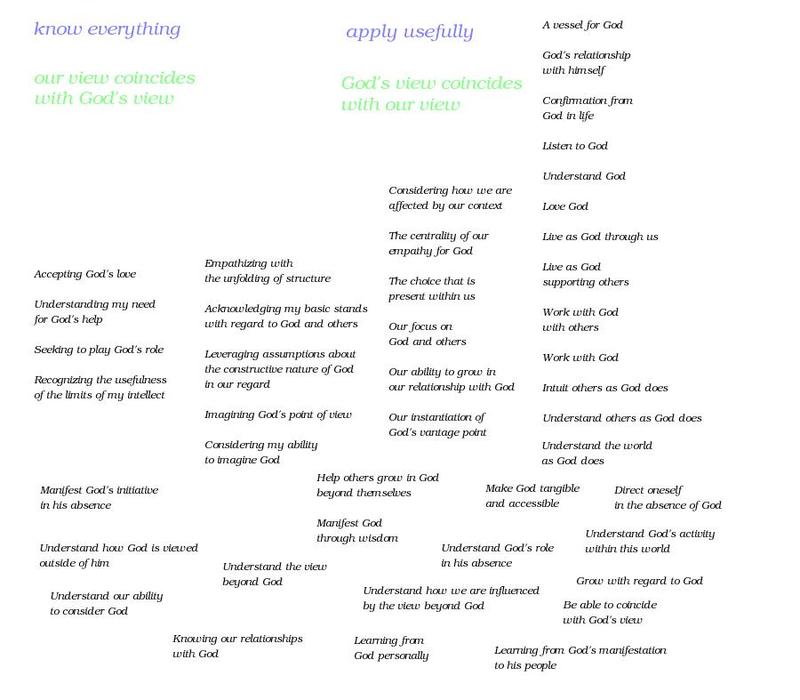Dievo šokis, Priėmimas, Viskas, Santykiai, Vaizduotė
Kaip priėjimai prie visumos derina visko žinojimą ir jo gražų taikymą?
- Kaip sudalyvauja Dievas ir visuma?
- Kaip šie priėjimai susiję su ryšiais su Dievu?
- Kuria prasme šie priėjimai yra Dievo raiškos Dievo šokyje?
- Kaip šiuos priėjimus suprasti kaip išsiaiškinimo būdus?
2006 metais sudariau sąrašą visų būdų kaip bandau viską žinoti ir tą žinojimą gražiai taikyti. Kiekviename būde įžvelgiau ryšį su Dievu, kaip Dievas mane myli ir kaip tai atveria galimybę mylėti kitus. Šiuos būdus rūšiavau.
Savo žvilgsniu į Dievo žvilgsnį žinome viską. O Dievo žvilgsniu į savo žvilgsnį deramai taikome tą žinojimą. Visko žinojimu pažįstame Dievą, o pažinę Dievą juo gyvename savimi. Tad visko žinojimas yra gyvenimas, o jo gražus taikymas yra amžinas gyvenimas.
Gyvenimas: Savo žvilgsniu į Dievo žvilgsnį. Esame mylimi. Išgyvename įvairias įtampas nes Dievo akivaizdoje suvokiame, kad gyvename savimi.
- Gyvenimas. Pasaulis (Dievo nebuvimas): Ar esame mylimi. Pajutimas, kad esu mylimas. Jaučiu Dievo meilę, nors Dievo ir nejaučiu.
- Betkas. Aš (Kito nebuvimas): Kokie esame mylimi. Įsivaizdavimas savo būklės kūrėjo.
- Pasirinkimai. Kitas: Kaip esame mylimi. Atsirėmimas į savo nuostatas, kokią prasmę priskiriu savo būklei.
- Valia. Dievas: Kodėl esame mylimi. Dievo vaidmens įsivaizdavimas, priėmimas ir įgyvendinimas.
Amžinas gyvenimas: Dievo žvilgsniu į savo žvilgsnį. Mylime. Išgyvename ramybę nes gyvename Dievu.
- Dievo valia. Kodėl mylime. Išgirsti Dievą.
- Gera valia. Kaip mylime. Bendru žmogumi gyventi kitais.
- Išmintis. Ką mylime. Suprasti kitus Dievo kampu.
- Amžinas gyvenimas. Ar mylime. Gyventi Dievo vietininku.
Panašiai, kada gyvenau pas Senelę, maždaug 1996 metais, apžvelgiau kiekvienos sandaros tikslą ir tai padėjo įžvelgti keturias pirmines sandaras.
Overview of Approaches
I wish to know everything and apply that usefully. This comes together in a profusion of approaches. Each of them asserts our relationship with God, how we are loved by him, and how our love opens the way for others. Here is a list of approaches. I am now organizing these approaches.
- KnowEverything Our view coincides with God's view because we go where he expects us. Structure unfolds to express the world (absence of God), us (absence of other), other (sevensome) and God (eightsome). These are various degrees of empathy, thus sensitivity.
- Life: Whether we are loved - World (absence of God) There is great tension between the absence of God and the fact that we are loved. God as God. God is simply a concept.
- Accepting God's love As a child, I felt loved.
- Anything: What we are loved as - Me (absence of other) There is tension in the fact that we are created, placed in a situation, but there is no other to share our view with. God as everything. God is a point of view.
- Imagining God's point of view I imagine [GodsView God's point of view] when he is all by himself, prior to everything.
- Understand the view beyond God imagining the perspective of the System
- Identifying with and engaging the possibility of transcending my limits
- Understanding my need for God's help I had an ExistentialConversation with God.
- Noting the limits of my situation
- Structure as the limits of my imagination
- The centrality of our empathy for God human's view of God's view as the fundamental building block of structure
- Recognizing the usefulness of the limits of my intellect I sought and found Absolutes: Everything, DivisionsOfEverything, Representations, Topologies, PrimaryStructures, SecondaryStructures.
- Empathizing with the unfolding of structure I observed how Structure unfolds.
- Choosing, How we are loved - Other There is tension in that I am taught and there is an Other who I may live as. God as wishing. God as a choice.
- Acknowledging my basic stands with regard to God and others I realized what I choose to believe in any event: LoveGod and [LoveNeighbor love my neighbor as myself].
- Using my structural limits as a guide to prefer minimalization
- Leveraging assumptions about the constructive nature of God in our regard I leverage ConstructiveHypotheses.
- Understand our ability to consider God the study of Definition
- Structure as allowing two hearts to relate within a system
- Consider the effect of a Godless context
- Understand how we are influenced by the view beyond God human is taught by system (and is thereby the Son of Man)
- Considering how we are affected by our context the context in which human is placed
- The choice that is present within us Jesus Christ's IAmStatements as the relationship between Life and EternalLife
- Allowing for the absence of God for the sake of minimalization, and accepting his absence as our situation
- Will, Why we are loved - God There is tension in that I am a vessel for God, and there is God who may live through me. God as love.
- Seeking to play God's role I wished to KnowEverything and [ApplyUsefully apply that usefully].
- Stepping into God's view
- Be able to coincide with God's view TheChainOfViews and the metaphor of the LostChild
- Grow with regard to God the growth of Understanding
- Identifying God through his absence by way of his love
- Understand how God is viewed outside of him System and Definition as the relationship between God and Human
- Understand God's activity within this world Life as the coinciding of God beyond us and God within us (the Heart) (sensitivity and responsivity)
- Understand God's role in his absence to know what it means to KnowEverything and [ApplyUsefully apply that knowledge usefully]
- Considering my ability to imagine God the contexts in which we may imagine God, perhaps eight in all
- Life: Whether we are loved - World (absence of God) There is great tension between the absence of God and the fact that we are loved. God as God. God is simply a concept.
- ApplyUsefully God's view coincides with ours because we open the way for him. We be farther and father from what is loved so that the world, then us, then other, then God can coincide with us. This is a view of the same structural limits, but in the reverse direction, in terms of heart rather than God. God is a creator by making way, thus being responsive, and allowing us to likewise make way, which shows that we can be at best co-creators, giving slack as it was given to us. This also suggest that God is a sad God.
- A vessel for God Human as the minimal structure in which God may fully manifest himself
- God's relationship with himself the Omniscope as God's pulling away from himself, so that human is his lens
- Our instantiation of God's vantage point the chain of stepping out, of self
- Our ability to grow in our relationship with God the growth of Love
- Knowing our relationships with God the relationship between the two chains - stepping in and stepping out - by way of four levels
- Our focus on God and others human's Empathy for God and Other
- the relationship between Observer and Observed by way of their ObservationalPlane
- Confirmation from God in life I seek [ApplyUsefully practical application], to love ever more broadly:
- God's will, Why we love:
- Listen to God the ability to converse with God and engage his will and live by it
- Understand God familiarity with God's key concept of Love
- Love God the ability to LoveGod
- Learning from God personally what God reveals through Prayer
- GoodWill, How we love:
- Live as God through us the ability to train ourselves, to learn to live hyperflexibly like Jesus, as a person-in-general who does what any good person would do, rather than as a person-in-particular who focuses on what makes them different
- Live as God supporting others the ability to take up the key concepts of others
- Work with God with others the ability to cooperate in working out various portion of these challenges
- Work with God the ability to respond effectively to challenges to people throughout the world
- Learning from God's manifestation through others recognizing God's presence in others
- Wisdom, What we love:
- Intuit others as God does the ability to express and comprehend anybody's intuition regarding what they know intuitively
- Understand others as God does the ability to translate across private languages, making use of a conceptual language of universal structures
- Understand the world as God does the ability to generate and catalogue the patterns of recurring activity (as in Christopher Alexander's The Pattern Language) which evoke the world around us that we live in
- Help others grow in God beyond themselves the ability to pursue the investigatory question of others
- Manifest God through wisdom the ability to answer any question
- Make God tangible and accessible the manifestation of truth so that it is accessible to all who wish for it
- Learning from God's manifestation to his people what God reveals through Scripture
- EternalLife, Whether we love:
- Manifest God's initiative in his absence the ability to reach out to others, engage them, and help them grow
- Direct oneself in the absence of God to understand what to do, how to apply oneself
From prayer, I think that we can understand and pull together these many approaches by considering how each involves a relationship of love with God and how that opens up space to allow for an other. God loves us, and that love separates us (in that it has God go beyond himself) and that separation allows for an other, but especially when we also love (and go beyond ourselves) and thereby grow.

2006 m. balandžio mėn. 4 d.
PriėjimaiPrieVisumos
Naujausi pakeitimai
网站
Įvadas #E9F5FC
Klausimai #FFFFC0
Teiginiai #FFFFFF
Kitų mintys #EFCFE1
Dievas man #FFECC0
Iš ankščiau #CCFFCC
Mieli skaitytojai, visa mano kūryba ir kartu visi šie puslapiai yra visuomenės turtas, kuriuo visi kviečiami laisvai naudotis, dalintis, visaip perkurti. - Andrius
